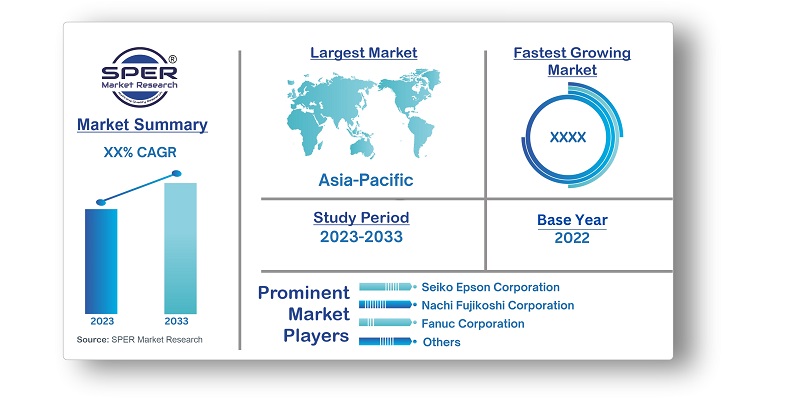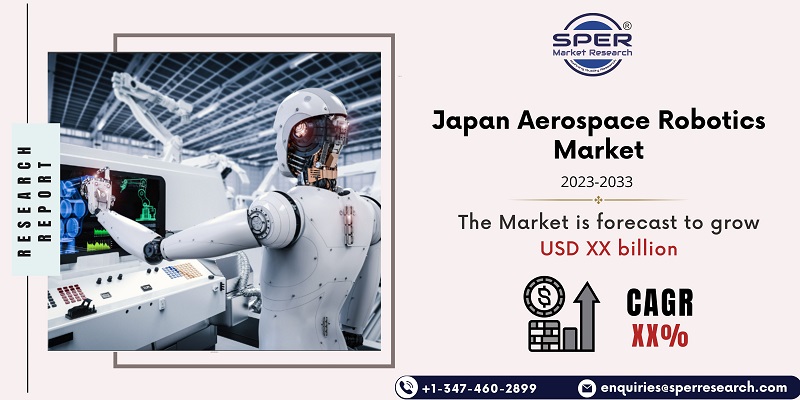
Japan Aerospace Robotics Market Growth, Size, Trends, Revenue, Share, Scope and Future Outlook
Japan Aerospace Robotics Market Size- By Component Type, By Type, By Technology, By Application, By Payload- Regional Outlook, Competitive Strategies and Segment Forecast to 2033
| Published: Dec-2023 | Report ID: AERO2339 | Pages: 1 - 102 | Formats*: |
| Category : Aerospace and Defence | |||
- December 2020: Mercedes-Benz placed an order with KUKA for the engineering, building, assembly, and commissioning of multiple body-in-white production lines. This location will produce a range of car models in the future.
- May 2021: Kawasaki Heavy Industries that it has received an order for an AUV named SPICE from Modus Subsea Services Limited (MODUS) in the UK. Built on a combination of industrial robot technologies and submarine-related technologies developed over many years at Kawasaki, SPICE is the first autonomous underwater vehicle (AUV) in the world with a robot arm for conducting subsea pipeline inspections.


| Report Metric | Details |
| Market size available for years | 2019-2033 |
| Base year considered | 2022 |
| Forecast period | 2023-2033 |
| Segments covered | By Component Type, By Type, By Technology, By Application, By Payload |
| Regions covered | Central/ Chubu Region, Chugoku Region, Hokkaido Region, Kansai/Kinki Region, Kanto Region, Kyushu-Okinawa Region, Shikoku Region, Tohoku Region |
| Companies Covered | Seiko Epson Corporation, Nachi Fujikoshi Corporation, Fanuc Corporation, Kawasaki Heavy Industries Ltd, Mitsubishi Electric Corporation, ABB, Yaskawa Electric Corporation, KUKA AG, Universal Robots A/S and various others. |
- Aerospace Manufacturers
- Aerospace Component Suppliers:
- Robotics and Automation Companies
- Research and Development Institutions
- Government Agencies and Regulators
- Investors and Venture Capitalists
- System integrators offering turnkey solutions for aerospace automation.
- Training and Education Providers
- Industry Associations and Trade Groups
| By Component Type: |
|
| By Type: |
|
| By Technology: |
|
| By Application: |
|
| By Payload: |
|
- Japan Aerospace Robotics Market Size (FY’2023-FY’2033)
- Overview of Japan Aerospace Robotics Market
- Segmentation of Japan Aerospace Robotics Market By Component Type (Arm Processor, Camera and Sensors, Controller, End Effector, Others)
- Segmentation of Japan Aerospace Robotics Market By Type (Articulated, Cartesian, SCARA, Parallel, Others)
- Segmentation of Japan Aerospace Robotics Market By Technology (Collaborative, Traditional)
- Segmentation of Japan Aerospace Robotics Market By Application (Drilling, Inspection, Painting, Welding, Others)
- Segmentation of Japan Aerospace Robotics Market By Payload (Up to 16.00 KG, 16.01–60.00 KG, 60.01–225.00 KG, More Than 225.00 KG)
- Statistical Snap of Japan Aerospace Robotics Market
- Expansion Analysis of Japan Aerospace Robotics Market
- Problems and Obstacles in Japan Aerospace Robotics Market
- Competitive Landscape in the Japan Aerospace Robotics Market
- Impact of COVID-19 and Demonetization on Japan Aerospace Robotics Market
- Details on Current Investment in Japan Aerospace Robotics Market
- Competitive Analysis of Japan Aerospace Robotics Market
- Prominent Players in the Japan Aerospace Robotics Market
- SWOT Analysis of Japan Aerospace Robotics Market
1.1. Scope of the report1.2. Market segment analysis
2.1. Research data source2.1.1. Secondary Data2.1.2. Primary Data2.1.3. SPER’s internal database2.1.4. Premium insight from KOL’s2.2. Market size estimation2.2.1. Top-down and Bottom-up approach2.3. Data triangulation
4.1. Driver, Restraint, Opportunity and Challenges analysis4.1.1. Drivers4.1.2. Restraints4.1.3. Opportunities4.1.4. Challenges4.2. COVID-19 Impacts of the Japan Aerospace Robotics Market
5.1. SWOT Analysis5.1.1. Strengths5.1.2. Weaknesses5.1.3. Opportunities5.1.4. Threats5.2. PESTEL Analysis5.2.1. Political Landscape5.2.2. Economic Landscape5.2.3. Social Landscape5.2.4. Technological Landscape5.2.5. Environmental Landscape5.2.6. Legal Landscape5.3. PORTER’s Five Forces5.3.1. Bargaining power of suppliers5.3.2. Bargaining power of buyers5.3.3. Threat of Substitute5.3.4. Threat of new entrant5.3.5. Competitive rivalry5.4. Heat Map Analysis
6.1. Japan Aerospace Robotics Market Manufacturing Base Distribution, Sales Area, Product Type6.2. Mergers & Acquisitions, Partnerships, Product Launch, and Collaboration in Japan Aerospace Robotics Market
7.1. Japan Aerospace Robotics Market Value Share and Forecast, By Component Type, 2023-20337.2. Arm Processor7.3. Camera and Sensors7.4. Controller7.5. End Effector7.6. Others
8.1. Japan Aerospace Robotics Market Value Share and Forecast, By Type, 2023-20338.2. Articulated8.3. Cartesian8.4. SCARA8.5. Parallel8.6. Others
9.1. Japan Aerospace Robotics Market Value Share and Forecast, By Technology, 2023-20339.2. Collaborative9.3. Traditional
10.1. Japan Aerospace Robotics Market Value Share and Forecast, By Application, 2023-203310.2. Drilling10.3. Inspection10.4. Painting10.5. Welding10.6. Others
11.1. Japan Aerospace Robotics Market Value Share and Forecast, By Payload, 2023-203311.2. Up to 16.00 KG11.3. 16.01–60.00 KG11.4. 60.01–225.00 KG11.5. More Than 225.00 KG
12.1. Japan Aerospace Robotics Market Size and Market Share
13.1. Japan Aerospace Robotics Market Size and Market Share By Component Type (2019-2026)13.2. Japan Aerospace Robotics Market Size and Market Share By Component Type (2027-2033)
14.1. Japan Aerospace Robotics Market Size and Market Share By Type (2019-2026)14.2. Japan Aerospace Robotics Market Size and Market Share By Type (2027-2033)
15.1. Japan Aerospace Robotics Market Size and Market Share By Technology (2019-2026)15.2. Japan Aerospace Robotics Market Size and Market Share By Technology (2027-2033)
16.1. Japan Aerospace Robotics Market Size and Market Share By Application (2019-2026)16.2. Japan Aerospace Robotics Market Size and Market Share By Application (2027-2033)
17.1. Japan Aerospace Robotics Market Size and Market Share By Payload (2019-2026)17.2. Japan Aerospace Robotics Market Size and Market Share By Payload (2027-2033)
18.1. Japan Aerospace Robotics Market Size and Market Share By Region (2019-2026)18.2. Japan Aerospace Robotics Market Size and Market Share By Region (2027-2033)18.3. Central/ Chubu Region18.4. Chugoku Region18.5. Hokkaido Region18.6. Kansai/Kinki Region18.7. Kanto Region18.8. Kyushu-Okinawa Region18.9. Shikoku Region18.10. Tohoku Region
19.1. ABB19.1.1. Company details19.1.2. Financial outlook19.1.3. Product summary19.1.4. Recent developments19.2. Fanuc Corporation19.2.1. Company details19.2.2. Financial outlook19.2.3. Product summary19.2.4. Recent developments19.3. Kawasaki Heavy Industries Ltd19.3.1. Company details19.3.2. Financial outlook19.3.3. Product summary19.3.4. Recent developments19.4. KUKA AG19.4.1. Company details19.4.2. Financial outlook19.4.3. Product summary19.4.4. Recent developments19.5. Mitsubishi Electric Corporation19.5.1. Company details19.5.2. Financial outlook19.5.3. Product summary19.5.4. Recent developments19.6. Nachi Fujikoshi Corporation19.6.1. Company details19.6.2. Financial outlook19.6.3. Product summary19.6.4. Recent developments19.7. Seiko Epson Corporation19.7.1. Company details19.7.2. Financial outlook19.7.3. Product summary19.7.4. Recent developments19.8. Yaskawa Electric Corporation19.8.1. Company details19.8.2. Financial outlook19.8.3. Product summary19.8.4. Recent developments15.9 Universal Robots A/S15.9.1 Company details15.9.2 Financial outlook15.9.3 Product summary15.9.4 Recent developments15.20 Others
SPER Market Research’s methodology uses great emphasis on primary research to ensure that the market intelligence insights are up to date, reliable and accurate. Primary interviews are done with players involved in each phase of a supply chain to analyze the market forecasting. The secondary research method is used to help you fully understand how the future markets and the spending patterns look likes.
The report is based on in-depth qualitative and quantitative analysis of the Product Market. The quantitative analysis involves the application of various projection and sampling techniques. The qualitative analysis involves primary interviews, surveys, and vendor briefings. The data gathered as a result of these processes are validated through experts opinion. Our research methodology entails an ideal mixture of primary and secondary initiatives.



Frequently Asked Questions About This Report
PLACE AN ORDER
Year End Discount
Sample Report
Pre-Purchase Inquiry
NEED CUSTOMIZATION?
Request CustomizationCALL OR EMAIL US
100% Secure Payment






Related Reports
Our Global Clients
Our data-driven insights have influenced the strategy of 200+ reputed companies across the globe.




















